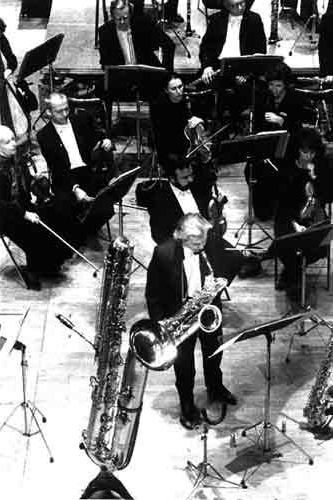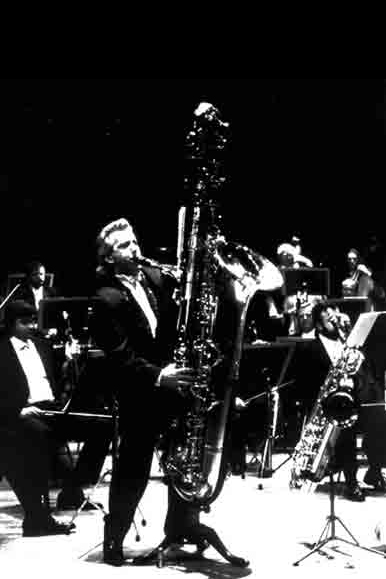Biography
Daniel Kientzy was born in Périgueux (1) en 1951. A professional musician before the age of 16, he played the bass guitar in dance and pop bands. Later, by chance, and almost beyond the age limit, he came into contact with classical music, entering the saxophone class (3) of the Limoges Conservatory thanks to M. Decouais (2) who admitted him in the middle of the academic year. While attending the Paris Conservatory, he studied the double bass at the Versailles Conservatory with M. Cazauran. A year or two later he was playing this instrument with a provincial opera company. He also studied early music and period instruments: the viola da gamba, the crumhorns, the cornamusen, recorders, forming the ensemble Musica Ficta, the repertory of which covered the medieval, renaissance and baroque periods.Various circumstances (4) ed him to study acoustics, electro-acoustics, recording techniques and signal processing. This also led him to take a doctoral degree in aesthetics, sciences and art technology. His training in contemporary music (5), took place with the composers (6) themselves (7).
When the necessity arose, in 1979/80, of devoting himself entirely to contemporary music, he chose the saxophone(s) as sole instrument(s) (8). His identification with the avant-garde and the absence of a repertory very soon led him to become the ‘inventor’ of the modern saxophone.
He undertook unprecedented research into the seven members of the saxophone family (9). Thanks to impeccable logic, a rare eye for detail and remarkable intuition, he succeeded in establishing a fundamental renewal of the potential of these aerophones, one that concerns both tone-colour and expression (10). The fruits of his research are to be found in several works, most notably the monumental and revolutionary, unique in the history of music : Saxologie
In parallel, he commenced an extraordinary artistic collaboration with dozens upon dozens of composers from extremely diverse geographical and aesthetic horizons, which has led to the production of more than 700 works (11) ; which are, for him, so many worlds that he inhabits quite separately one from another and to which he devotes himself, infusing them with life in the course of an essentially international career entirely devoted to contemporary activity. At the same time, his instrumental eloquence established the saxophone(s) as an undisputed (12) solo instrument in the contemporary music scene.
A profoundly independent artist, he has, however, never wanted to create a school, though one can inevitably refer to the saxophone ‘before Kientzy’ and ‘since Kientzy’. Moreover, though he does not teach, his treatises form an unprecedented pedagogical contribution of value to both composers and performers.
In masterly manner he has broadened the scope of performance by including electro-acoustic techniques, as concerns both recording (which in most cases he controls directly in accordance with the specificities of the medium (13)) and mixed media performance (14) for which, together with Reina Portuondo, he created Enneaphony (15), a tool for meta-chamber music. In this respect, physical and/or artificial spatialisation are added to natural performance features. This alchemy of course incorporates all possible tone-colourings, sound transformations, temporal shifts and other sound changes by these electro-acoustic means considered from an instrumental point of view as a prolongation of instrumental performance in the service of his artistic conception and musical approach (16). The musical treatment of these features (17), gives rise to what may be termed an organo-intrumental (14) interpretative Art (18).
As his object is to be the expressive medium between the composer, or more precisely the composition, and the audience, his expressive powers quickly developed a veritable contemporary lyricism (19). He brings to bear on this all the transcendental means possible for breathing life into this “art in time that reaches beyond time”, for such is the way he considers and lives music.
Contemporary music is absolutely natural for him, and what, on paper, may appear to be an experiment, whether simple or complex, or indeed a purely intellectual construction, is absorbed by him as a pure work of art.
Making use of his vast experience as a performer, and with both exceptional aesthetic demands and a fundamental sense of musical art, he is also a remarkable performer of improvised music.
It should be stressed that he is the only performer in the world to play all seven saxophones, which he masters with unlarged and unprecedented virtuosity (20) Between these instruments, and together with the new paths he has opened up for them, he juggles with the most complex techniques for intense, deep, sensual, spontaneous musical expression. Yet his celebrated stage presence (21) has no other justification than the intensity of his commitment to the works he performs and his “shamanic” conception of a concert (22).
Far from being self-taught, his art nonetheless owes nothing to imitation. He draws solely on the intrinsic possibilities of his instruments and on his broadened artistic perception of all that genuinely constitutes music, guided by a certain idea stemming from it of a ‘primal music’, the experience of which is renewed and deepened every day.
Through his own phonographic productions (23) , which he considers a separate and fully-fledged form of interpretation, he fully embodies the updated concept of ‘total performer’. He is an artiste of authenticity, and with his research, his treatises, his unprecedented knowledge of the whole family of saxophones, his unusual tone-colours, his musical charisma (24), his phenomenal technique, his extraordinary potential (25), his record-breaking number of world premieres (26), his instrumental mastery of electro-acoustics, his introduction of spatial concepts into (meta-) instrumental performance, his creation of an organo-acoustic interpretative art (14) his art of improvised musical creation, his musical rigour in the most complex works, he is also, though already an accomplished artiste of the twentieth century, the prototype of the performer one could dream of for the twenty-first century.
Reina Portuondo
(1) Brought up in the poor district of this peaceful, under-developed town in the south-west of France, his musical faculties could only find an outlet in popular music. → Resume reading
(2) A remarkable teacher, without whom Kientzy would probably never have become a professional in art music, of which he had, in a confused way, dreamed for a long time. → Resume reading
(3) He had taken up the saxophone in case of military service, which, thankfully, he did not have to assume. → Resume reading
(4) Including various collaborations with INA and working for IRCAM (1981-86). → Resume reading
(5) Which, a priori, he liked, but only encountered after his academic music studies. → Resume reading
(6) And in their aesthetic diversity multiplied by their internationality. → Resume reading
(7) He escaped from the mimetisms, neo-academicism and other fads of ‘pseudo-contemporary fashion’. → Resume reading
(8) Though he knows them and appreciates their potential better than anyone, Kientzy is fortunate not to love saxophones per se but rather the music that these supple tools enable him to realise and bring alive. → Resume reading
(9) On quite standard instruments: Vandoren reeds and mouthpieces, Selmer saxophones (except for the specially made contra-bass). → Resume reading
(10) Correlatively, from his point of view as an instrumentalist, he acquired total freedom from prejudice, obscurantism, fetishism and other forms of irrational and out of place sacralisation thanks to a ultimately enlightened perception of the instrumental sound phenomenon. → Resume reading
(11) Written for him and illustrating all contemporary forms and genres. Cf. Repertory. → Resume reading
(12) Undisputed because based solely on the contents of the works performed and not on the names of a few composers who are “well-known” (within official circles and no doubt soon to be (re)considered by posterity). → Resume reading
(13) From his initial instrumental playing to the finished CD. → Resume reading
(14) “Organo-acousmatic”: live performance + fixed sounds (tape) and/or live electronics. → Resume reading
(15) cf.Repertoire § A. → Resume reading
(16) ‘Futurist’ for some, quite simply current and natural for Kientzy. → Resume reading
(17) With supreme consciousness of the subtle limits in the use of electro-acoustic potential combined with a reshaped instrumental play, with tone-colours, inflections, envelopes and agogics in osmosis with the acousmatic layer in which they are embedded. → Resume reading
(18) Realised by Meta Duo in a subtle, proliferating and ‘honest’ sound magic. → Resume reading
(19) Light-years removed from the frigidity of the so-called objectivity (often chopped up into sterile instability) that constantly bedevils performances of contemporary music. → Resume reading
(20) In which the traditional is completely included but which constitutes only a modest and insufficient part of a vast broadening of organo-technico-acoustic expressive musical demands. → Resume reading
(21) Free of cliches, systematic redundancy of gestures and a permanently predictable visual aspect, and, when necessary, including visual and spoken theatrical elements, comparable, for some, with ‘performance art’. → Resume reading
(22) Which, according to Kientzy, holds only for projecting – for the duration of the concert – the senses and the spirit of his public out of time, together with the psychic and material contingencies of ‘every day life’. → Resume reading
(23) Especially those in the organo-acousmatic domain. → Resume reading
(24) Capable also of enchanting the uninitiated (in contemporary music), to whom in particular Kientzy addresses himself. → Resume reading
(25) He alone is able to play some works. → Resume reading
(26) Both as regards concerts and phonograms. → Resume reading
(27) En résumé, le son NORMAL, est :
– le centre de gravite acoustico-expressif autour duquel évoluent tous les autres modes de jeu,
– la voix calme sur laquelle il peut y avoir des accents, et qui peut se colorer, devenir autre (mode de jeu),
– le son de base.
Il doit pouvoir “glisser” vers les autres modes de jeux ou inflexions sans difficulté, et en revenir de même.
Le son NORMAL doit :
– être d’une dynamique étendue
– paraître naturel
– être lisse mais charnu, ni gros ni maigre, riche sans ostentation et sobre sans fadeur
– sembler produit sans effort ni contrainte
– être stable, “relax”, sans affectation, équilibré
– paraître “simple”, “ni trop ceci ni trop cela”
– être “lisse” mais en même temps personnel.
Chaque individu (singulier par nature) ayant une “stabilité” qui lui est propre, la personnalité du son a toutes les chances de se manifester naturellement, si elle prend le soin de ne pas se dissoudre sous des diktats castrateurs et / ou uniformisants.
Le son NORMAL requière:
– un Bec “neutre” (ne privilégiant pas certaines parties du spectre) et homogène autant dans les “registres” que dans les enveloppes
– des anches souples
– un embouchage ferme et ductile
– une cavité buccale polymorphe s’harmonisant en anticipation avec les différentes configurations du tuyau (selon les doigtés) qui impriment à l’anche ses différentes vitesses d’oscillation
-Tout et / mais pas plus que ce qui est nécessaire a la mise en oscillation de l’anche (aux vitesses imprimées par les différentes configurations du tuyau elle mêmes en harmonie avec la cavité buccale).






